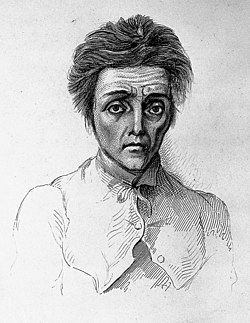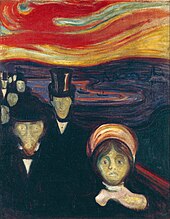| Anxiety | |
|---|---|
 | |
| A person diagnosed with panphobia, from Alexander Morison's 1843 book The Physiognomy of Mental Diseases. | |
| Classification and external resources | |
| Specialty | Psychiatry, psychology |
Anxiety is an emotion characterized by an unpleasant state of inner turmoil, often accompanied by nervous behaviour such as pacing back and forth, somatic complaints, and rumination. It is the subjectively unpleasant feelings of dread over anticipated events, such as the feeling of imminent death. Anxiety is not the same as fear, which is a response to a real or perceived immediate threat, whereas anxiety involves the expectation of future threat. Anxiety is a feeling of uneasiness and worry, usually generalized and unfocused as an overreaction to a situation that is only subjectively seen as menacing. It is often accompanied by muscular tension, restlessness, fatigue and problems in concentration. Anxiety can be appropriate, but when experienced regularly the individual may suffer from an anxiety disorder.
People facing anxiety may withdraw from situations which have provoked anxiety in the past. There are various types of anxiety. Existential anxiety can occur when a person faces angst, an existential crisis, or nihilistic feelings. People can also face mathematical anxiety, somatic anxiety, stage fright, or test anxiety. Social anxiety and stranger anxiety are caused when people are apprehensive around strangers or other people in general. Furthermore, anxiety has been linked with physical symptoms such as IBS and can heighten other mental-health illnesses such as OCD and panic disorder. The first step in the management of a person with anxiety symptoms involves evaluating the possible presence of an underlying medical cause, whose recognition is essential in order to decide the correct treatment. Anxiety symptoms may mask an organic disease, or appear associated with or as a result of a medical disorder.
Anxiety can be either a short-term "state" or a long-term "trait". Whereas trait anxiety represents worrying about future events, anxiety disorders are a group of mental disorders characterized by feelings of anxiety and fear. Anxiety disorders are partly genetic but may also be due to drug use, including alcohol, caffeine, and benzodiazepines (which are often prescribed to treat anxiety), as well as withdrawal from drugs of abuse. They often occur with other mental disorders, particularly bipolar disorder, eating disorders, major depressive disorder, or certain personality disorders. Common treatment options include lifestyle changes, medication, and therapy. Metacognitive therapy seeks to diminish anxiety through reducing worry, which is seen as a consequence of metacognitive beliefs.
Fear
A job applicant with a worried facial expression
Anxiety is distinguished from fear, which is an appropriate cognitive and emotional response to a perceived threat. Anxiety is related to the specific behaviors of fight-or-flight responses,
defensive behavior or escape. It occurs in situations only perceived as
uncontrollable or unavoidable, but not realistically so. David Barlow defines anxiety as "a future-oriented mood state in which one is not ready or prepared to attempt to cope with upcoming negative events,"
and that it is a distinction between future and present dangers which
divides anxiety and fear. Another description of anxiety is agony,
dread, terror, or even apprehension. In positive psychology, anxiety is described as the mental state that results from a difficult challenge for which the subject has insufficient coping skills.
Fear and anxiety can be differentiated in four domains: (1)
duration of emotional experience, (2) temporal focus, (3) specificity of
the threat, and (4) motivated direction. Fear is short lived, present
focused, geared towards a specific threat, and facilitating escape from
threat; anxiety, on the other hand, is long-acting, future focused,
broadly focused towards a diffuse threat, and promoting excessive
caution while approaching a potential threat and interferes with
constructive coping.
Symptoms
Anxiety
can be experienced with long, drawn out daily symptoms that reduce
quality of life, known as chronic (or generalized) anxiety, or it can be
experienced in short spurts with sporadic, stressful panic attacks, known as acute anxiety.
Symptoms of anxiety can range in number, intensity, and frequency,
depending on the person. While almost everyone has experienced anxiety
at some point in their lives, most do not develop long-term problems
with anxiety.
Anxiety may cause psychiatric and physiological symptoms.
The risk of anxiety leading to depression could possibly even
lead to an individual harming themselves, which is why there are many
24-hour suicide prevention hotlines.
The behavioral effects of anxiety may include withdrawal from
situations which have provoked anxiety or negative feelings in the past.
Other effects may include changes in sleeping patterns, changes in
habits, increase or decrease in food intake, and increased motor tension
(such as foot tapping).
The emotional effects of anxiety may include "feelings of
apprehension or dread, trouble concentrating, feeling tense or jumpy,
anticipating the worst, irritability, restlessness, watching (and
waiting) for signs (and occurrences) of danger, and, feeling like your
mind's gone blank" as well as "nightmares/bad dreams, obsessions about sensations, déjà vu, a trapped-in-your-mind feeling, and feeling like everything is scary."
The cognitive effects of anxiety may include thoughts about
suspected dangers, such as fear of dying. "You may ... fear that the
chest pains are a deadly heart attack or that the shooting pains in your
head are the result of a tumor or an aneurysm. You feel an intense fear
when you think of dying, or you may think of it more often than normal,
or can't get it out of your mind."
The physiological symptoms of anxiety may include:
- Neurological, as headache, paresthesias, vertigo, or presyncope.
- Digestive, as abdominal pain, nausea, diarrhea, indigestion, dry mouth, or bolus.
- Respiratory, as shortness of breath or sighing breathing.
- Cardiac, as palpitations, tachycardia, or chest pain.
- Muscular, as fatigue, tremors, or tetany.
- Cutaneous, as perspiration, or itchy skin.
- Uro-genital, as frequent urination, urinary urgency, dyspareunia, or impotence.
Types
Painting entitled Anxiety, 1894, by Edvard Munch
Existential
The philosopher Søren Kierkegaard, in The Concept of Anxiety
(1844), described anxiety or dread associated with the "dizziness of
freedom" and suggested the possibility for positive resolution of
anxiety through the self-conscious exercise of responsibility and
choosing. In Art and Artist (1932), the psychologist Otto Rank wrote that the psychological trauma
of birth was the pre-eminent human symbol of existential anxiety and
encompasses the creative person's simultaneous fear of – and desire for –
separation, individuation, and differentiation.
The theologian Paul Tillich characterized existential anxiety as "the state in which a being
is aware of its possible nonbeing" and he listed three categories for
the nonbeing and resulting anxiety: ontic (fate and death), moral (guilt and condemnation), and spiritual (emptiness and meaninglessness).
According to Tillich, the last of these three types of existential
anxiety, i.e. spiritual anxiety, is predominant in modern times while
the others were predominant in earlier periods. Tillich argues that this
anxiety can be accepted as part of the human condition
or it can be resisted but with negative consequences. In its
pathological form, spiritual anxiety may tend to "drive the person
toward the creation of certitude in systems of meaning which are
supported by tradition and authority" even though such "undoubted certitude is not built on the rock of reality".
According to Viktor Frankl, the author of Man's Search for Meaning, when a person is faced with extreme mortal dangers, the most basic of all human wishes is to find a meaning of life to combat the "trauma of nonbeing" as death is near.
Depending on the source of the threat, psychoanalytic theory distinguishes the following types of anxiety:
- realistic
- neurotic
- moral Hjelle, Larry; Ziegler, Daniel (1981). "Personality Theories: Basic Assumptions, Research, and Applications". McGraw-Hill. p. 494. ISBN 9780070290631.
Test and performance
According to Yerkes-Dodson law,
an optimal level of arousal is necessary to best complete a task such
as an exam, performance, or competitive event. However, when the anxiety
or level of arousal exceeds that optimum, the result is a decline in
performance.
Test anxiety is the uneasiness, apprehension, or nervousness felt by students who have a fear of failing an exam. Students who have test anxiety may experience any of the following: the association of grades with personal worth; fear of embarrassment by a teacher; fear of alienation
from parents or friends; time pressures; or feeling a loss of control.
Sweating, dizziness, headaches, racing heartbeats, nausea, fidgeting,
uncontrollable crying or laughing and drumming on a desk are all common.
Because test anxiety hinges on fear of negative evaluation, debate exists as to whether test anxiety is itself a unique anxiety disorder or whether it is a specific type of social phobia. The DSM-IV classifies test anxiety as a type of social phobia.
While the term "test anxiety" refers specifically to students,
many workers share the same experience with regard to their career or
profession. The fear of failing at a task and being negatively evaluated
for failure can have a similarly negative effect on the adult. Management of test anxiety focuses on achieving relaxation and developing mechanisms to manage anxiety.
Stranger, social, and intergroup anxiety
Humans generally require social acceptance and thus sometimes dread
the disapproval of others. Apprehension of being judged by others may
cause anxiety in social environments.
Anxiety during social interactions, particularly between
strangers, is common among young people. It may persist into adulthood
and become social anxiety or social phobia. "Stranger anxiety"
in small children is not considered a phobia. In adults, an excessive
fear of other people is not a developmentally common stage; it is called
social anxiety. According to Cutting, social phobics do not fear the crowd but the fact that they may be judged negatively.
Social anxiety
varies in degree and severity. For some people, it is characterized by
experiencing discomfort or awkwardness during physical social contact
(e.g. embracing, shaking hands, etc.), while in other cases it can lead
to a fear of interacting with unfamiliar people altogether. Those
suffering from this condition may restrict their lifestyles to
accommodate the anxiety, minimizing social interaction whenever
possible. Social anxiety also forms a core aspect of certain personality
disorders, including avoidant personality disorder.
To the extent that a person is fearful of social encounters with
unfamiliar others, some people may experience anxiety particularly
during interactions with outgroup members, or people who share different
group memberships (i.e., by race, ethnicity, class, gender, etc.).
Depending on the nature of the antecedent relations, cognitions, and
situational factors, intergroup contact may be stressful and lead to
feelings of anxiety. This apprehension or fear of contact with outgroup
members is often called interracial or intergroup anxiety.
As is the case the more generalized forms of social anxiety,
intergroup anxiety has behavioral, cognitive, and affective effects.
For instance, increases in schematic processing and simplified
information processing can occur when anxiety is high. Indeed, such is
consistent with related work on attentional bias in implicit memory.
Additionally recent research has found that implicit racial evaluations
(i.e. automatic prejudiced attitudes) can be amplified during
intergroup interaction.
Negative experiences have been illustrated in producing not only
negative expectations, but also avoidant, or antagonistic, behavior
such as hostility.
Furthermore, when compared to anxiety levels and cognitive effort
(e.g., impression management and self-presentation) in intragroup
contexts, levels and depletion of resources may be exacerbated in the
intergroup situation.
Trait
Anxiety can
be either a short-term 'state' or a long-term personality "trait".
Trait anxiety reflects a stable tendency across the lifespan of
responding with acute, state anxiety in the anticipation of threatening
situations (whether they are actually deemed threatening or not). A meta-analysis showed that a high level of neuroticism is a risk factor for development of anxiety symptoms and disorders. Such anxiety may be conscious or unconscious.
Personality can also be a trait leading towards anxiety and
depression. Through experience many find it difficult to collect
themselves due to their own personal nature.
Choice or decision
Anxiety
induced by the need to choose between similar options is increasingly
being recognized as a problem for individuals and for organizations. In 2004, Capgemini
wrote: "Today we're all faced with greater choice, more competition and
less time to consider our options or seek out the right advice."
In a decision context, unpredictability or uncertainty may
trigger emotional responses in anxious individuals that systematically
alter decision-making.
There are primarily two forms of this anxiety type. The first form
refers to a choice in which there are multiple potential outcomes with
known or calculable probabilities. The second form refers to the
uncertainty and ambiguity related to a decision context in which there
are multiple possible outcomes with unknown probabilities.
Anxiety disorders
Anxiety disorders are a group of mental disorders characterized by exaggerated feelings of anxiety and fear responses.
Anxiety is a worry about future events and fear is a reaction to
current events. These feelings may cause physical symptoms, such as a fast heart rate and shakiness. There are a number of anxiety disorders: including generalized anxiety disorder, specific phobia, social anxiety disorder, separation anxiety disorder, agoraphobia, panic disorder, and selective mutism. The disorder differs by what results in the symptoms. People often have more than one anxiety disorder.
The cause of anxiety disorders is a combination of genetic and environmental factors. Anxiety can stem itself from certain factors: genetics, medicinal side-effects, shortness of oxygen. Risk factors include a history of child abuse, family history of mental disorders, and poverty. Anxiety disorders often occur with other mental disorders, particularly major depressive disorder, personality disorder, and substance use disorder.
To be diagnosed symptoms typically need to be present at least six
months, be more than would be expected for the situation, and decrease
functioning. Other problems that may result in similar symptoms including hyperthyroidism, heart disease, caffeine, alcohol, or cannabis use, and withdrawal from certain drugs, among others.
Without treatment, anxiety disorders tend to remain. Treatment may include lifestyle changes, counselling, and medications. Counseling is typically with a type of cognitive behavioural therapy. Medications, such as antidepressants or beta blockers, may improve symptoms.
About 12% of people are affected by an anxiety disorder in a
given year and between 5-30% are affected at some point in their life. They occur about twice as often in women than they do in men, and generally begin before the age of 25.
The most common are specific phobia which affects nearly 12% and social
anxiety disorder which affects 10% at some point in their life. They
affect those between the ages of 15 and 35 the most and become less
common after the age of 55. Rates appear to be higher in the United
States and Europe.
Risk factors
A marble bust of the Roman Emperor Decius from the Capitoline Museum. This portrait "conveys an impression of anxiety and weariness, as of a man shouldering heavy [state] responsibilities".
Neuroanatomy
Neural circuitry involving the amygdala (which regulates emotions like anxiety and fear, stimulating the HPA Axis and sympathetic nervous system) and hippocampus (which is implicated in emotional memory along with the amygdala) is thought to underlie anxiety. People who have anxiety tend to show high activity in response to emotional stimuli in the amygdala.
Some writers believe that excessive anxiety can lead to an
overpotentiation of the limbic system (which includes the amygdala and
nucleus accumbens), giving increased future anxiety, but this does not
appear to have been proven.
Research upon adolescents who as infants had been highly apprehensive, vigilant, and fearful finds that their nucleus accumbens is more sensitive than that in other people when deciding to make an action that determined whether they received a reward.
This suggests a link between circuits responsible for fear and also
reward in anxious people. As researchers note, "a sense of
'responsibility', or self-agency, in a context of uncertainty
(probabilistic outcomes) drives the neural system underlying appetitive
motivation (i.e., nucleus accumbens) more strongly in temperamentally
inhibited than noninhibited adolescents".
Genetics
Genetics
and family history (e.g., parental anxiety) may predispose an
individual for an increased risk of an anxiety disorder, but generally
external stimuli will trigger its onset or exacerbation. Genetic differences account for about 43% of variance in panic disorder and 28% in generalized anxiety disorder. Although single genes are neither necessary nor sufficient for anxiety by themselves, several gene polymorphisms have been found to correlate with anxiety: PLXNA2, SERT, CRH, COMT and BDNF. Several of these genes influence neurotransmitters (such as serotonin and norepinephrine) and hormones (such as cortisol)
which are implicated in anxiety. The epigenetic signature of at least
one of these genes BDNF has also been associated with anxiety and
specific patterns of neural activity.
Medical conditions
Many medical conditions can cause anxiety. This includes conditions that affect the ability to breathe, like COPD and asthma, and the difficulty in breathing that often occurs near death. Conditions that cause abdominal pain or chest pain can cause anxiety and may in some cases be a somatization of anxiety; the same is true for some sexual dysfunctions. Conditions that affect the face or the skin can cause social anxiety especially among adolescents, and developmental disabilities often lead to social anxiety for children as well. Life-threatening conditions like cancer also cause anxiety.
Furthermore, certain organic diseases may present with anxiety or symptoms that mimic anxiety. These disorders include certain endocrine diseases (hypo- and hyperthyroidism, hyperprolactinemia), metabolic disorders (diabetes), deficiency states (low levels of vitamin D, B2, B12, folic acid), gastrointestinal diseases (celiac disease, non-celiac gluten sensitivity, inflammatory bowel disease), heart diseases, blood diseases (anemia), cerebral vascular accidents (transient ischemic attack, stroke), and brain degenerative diseases (Parkinson's disease, dementia, multiple sclerosis, Huntington's disease), among others.
Substance-induced
Several drugs can cause or worsen anxiety, whether in intoxication, withdrawal or from chronic use. These include alcohol, tobacco, cannabis, sedatives (including prescription benzodiazepines), opioids (including prescription pain killers and illicit drugs like heroin), stimulants (such as caffeine, cocaine and amphetamines), hallucinogens, and inhalants.
While many often report self-medicating anxiety with these substances,
improvements in anxiety from drugs are usually short-lived (with
worsening of anxiety in the long term, sometimes with acute anxiety as
soon as the drug effects wear off) and tend to be exaggerated. Acute
exposure to toxic levels of benzene may cause euphoria, anxiety, and irritability lasting up to 2 weeks after the exposure.
Psychological
Poor coping skills
(e.g., rigidity/inflexible problem solving, denial, avoidance,
impulsivity, extreme self-expectation, negative thoughts, affective
instability, and inability to focus on problems) are associated with
anxiety. Anxiety is also linked and perpetuated by the person's own
pessimistic outcome expectancy and how they cope with feedback
negativity. Temperament (e.g., neuroticism) and attitudes (e.g. pessimism) have been found to be risk factors for anxiety.
Cognitive distortions
such as overgeneralizing, catastrophizing, mind reading, emotional
reasoning, binocular trick, and mental filter can result in anxiety. For
example, an overgeneralized belief that something bad "always" happens
may lead someone to have excessive fears of even minimally risky
situations and to avoid benign social situations due to anticipatory
anxiety of embarrassment. In addition, those who have high anxiety can
also create future stressful life events.
Together, these findings suggest that anxious thoughts can lead to
anticipatory anxiety as well stressful events, which in turn cause more
anxiety. Such unhealthy thoughts can be targets for successful treatment
with cognitive therapy.
Psychodynamic theory posits that anxiety is often the result of opposing unconscious wishes or fears that manifest via maladaptive defense mechanisms (such as suppression, repression, anticipation, regression, somatization, passive aggression, dissociation) that develop to adapt to problems with early objects (e.g., caregivers) and empathic failures
in childhood. For example, persistent parental discouragement of anger
may result in repression/suppression of angry feelings which manifests
as gastrointestinal distress (somatization) when provoked by another
while the anger remains unconscious and outside the individual's
awareness. Such conflicts can be targets for successful treatment with psychodynamic therapy.
While psychodynamic therapy tends to explore the underlying roots of
anxiety, cognitive behavioral therapy has also been shown to be a
successful treatment for anxiety by altering irrational thoughts and
unwanted behaviors.
Evolutionary psychology
An evolutionary psychology explanation is that increased anxiety serves the purpose of increased vigilance
regarding potential threats in the environment as well as increased
tendency to take proactive actions regarding such possible threats. This
may cause false positive
reactions but an individual suffering from anxiety may also avoid real
threats. This may explain why anxious people are less likely to die due
to accidents.
When people are confronted with unpleasant and potentially harmful stimuli such as foul odors or tastes, PET-scans show increased bloodflow in the amygdala.
In these studies, the participants also reported moderate anxiety. This
might indicate that anxiety is a protective mechanism designed to
prevent the organism from engaging in potentially harmful behaviors.
Social
Social
risk factors for anxiety include a history of trauma (e.g., physical,
sexual or emotional abuse or assault), early life experiences and
parenting factors (e.g., rejection, lack of warmth, high hostility,
harsh discipline, high parental negative affect,
anxious childrearing, modelling of dysfunctional and drug-abusing
behaviour, discouragement of emotions, poor socialization, poor
attachment, and child abuse and neglect), cultural factors (e.g., stoic
families/cultures, persecuted minorities including the disabled), and
socioeconomics (e.g., uneducated, unemployed, impoverished (although
developed countries have higher rates of anxiety disorders than
developing countries).
Gender socialization
Contextual factors that are thought to contribute to anxiety include
gender socialization and learning experiences. In particular, learning
mastery (the degree to which people perceive their lives to be under
their own control) and instrumentality, which includes such traits as
self-confidence, independence, and competitiveness fully mediate the
relation between gender and anxiety. That is, though gender differences
in anxiety exist, with higher levels of anxiety in women compared to
men, gender socialization and learning mastery explain these gender
differences.
Research has demonstrated the ways in which facial prominence in
photographic images differs between men and women. More specifically, in
official online photographs of politicians around the world, women's
faces are less prominent than men's. The difference in these images
actually tended to be greater in cultures with greater institutional
gender equality.
Pathophysiology
Anxiety disorder appears to be a genetically inherited neurochemical
dysfunction that may involve autonomic imbalance; decreased GABA-ergic
tone; allelic polymorphism of the catechol-O-methyltransferase (COMT)
gene; increased adenosine receptor function; increased cortisol.
In the central nervous system
(CNS), the major mediators of the symptoms of anxiety disorders appear
to be norepinephrine, serotonin, dopamine, and gamma-aminobutyric acid
(GABA). Other neurotransmitters and peptides, such as
corticotropin-releasing factor, may be involved. Peripherally, the autonomic nervous system,
especially the sympathetic nervous system, mediates many of the
symptoms. Increased flow in the right parahippocampal region and reduced
serotonin type 1A receptor binding in the anterior and posterior
cingulate and raphe of patients are the diagnostic factors for
prevalence of anxiety disorder.
The amygdala is central to the processing of fear and anxiety,
and its function may be disrupted in anxiety disorders. Anxiety
processing in the basolateral amygdala has been implicated with
dendritic arborization of the amygdaloid neurons. SK2 potassium
channels mediate inhibitory influence on action potentials and reduce
arborization.
Joseph E. LeDoux and Lisa Feldman Barrett have both sought to separate automatic threat responses from additional associated cognitive activity within anxiety.


